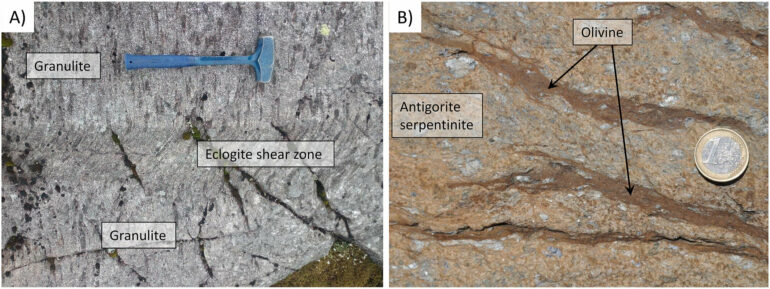In deep Earth, rocks take up and release water all the time, and the effects can be wide reaching. Dehydration can cause rocks to crack and trigger earthquakes, and over geologic timescales, this water cycling can influence plate tectonics and move continents.
Schmalholz and team asked how water can move through impermeable rocks, such as those found in mantle wedges, the deep lithosphere, and the lower crust. They hypothesize that certain reactions can cause temporary porosity in these rocks. By mathematically modeling the hydration and dehydration of rock at high pressure, they derived equations to estimate how the porosity of rock changes as water cycles through it.
The research is published in the journal Geochemistry, Geophysics, Geosystems.
Previous work suggested that at very high temperatures, minerals can react with each other to form denser minerals, squeezing water out of the minerals and generating less dense, more porous rocks in the process.
As the reaction progresses, a “dehydration front” moves through the rock. On the other hand, some reactions cause rocks to act like dry sponges, soaking up surrounding water and becoming denser. The progression of this reaction is known as a hydration front.
In the study, the researchers presented 1D simulations for three scenarios (one for a hydration front and two for dehydration fronts) in which a rock with no porosity becomes temporarily porous.
In a hydration reaction, water flows into the rock from an external source, so the hydration front always moves in the same direction as the fluid is flowing. Dehydration reactions have two possible scenarios. In simple dehydration, water flows out of the rock and into the surrounding environment, moving in the opposite direction of the dehydration front.
In the second scenario, called dehydration inflow, water is squeezed out of minerals, and additional water flows in to fill up the created porosity, so the fluid moves in the same direction as the dehydration front.
Whichever direction water is pushed, it has the potential to enter impermeable surrounding rocks if the reactions generate a porosity that allows for it. Describing how water moves through deep Earth is challenging, the researchers note, but their newly derived equations provide a framework for others researching how water drives geological processes beneath Earth’s surface.
More information:
Stefan M. Schmalholz et al, (De)hydration Front Propagation Into Zero‐Permeability Rock, Geochemistry, Geophysics, Geosystems (2024). DOI: 10.1029/2023GC011422
Provided by
American Geophysical Union
This story is republished courtesy of Eos, hosted by the American Geophysical Union. Read the original storyhere.
Citation:
High-pressure reactions can turn nonporous rocks into sponges (2024, September 23)



